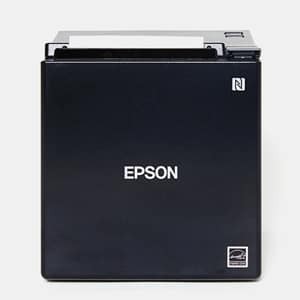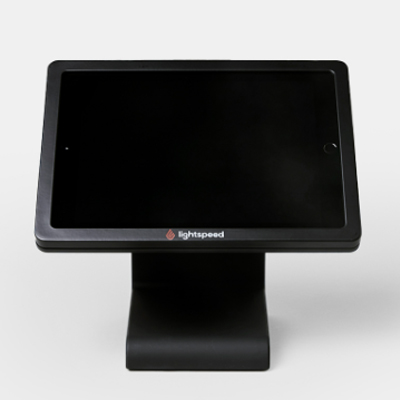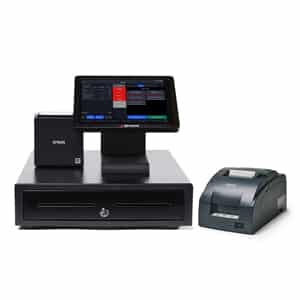Lightspeed Restaurant offers excellent reporting and inventory alongside flexible hardware, but it is pricier than competitors.
2024 Lightspeed Restaurant Review: Pricing, Features & More
This article is part of a larger series on POS Systems.
Lightspeed Restaurant is a user-friendly iPad point-of-sale (POS) system designed for restaurants. This system has expansive reporting capabilities and excellent inventory management. Getting the most out of the system requires enrolling in Lightspeed Payments. There are additional monthly fees if you want to use a third-party processor, which can get pricey.
Overall, Lightspeed’s Restaurant’s user-friendly interface, self-installable hardware, and excellent reporting earned it a 4.00 out of a possible 5 on our restaurant POS scoring criteria (which you can read in full below).
Lightspeed Restaurant Overview

Pros
- Operates on iPads
- High-level, detailed reporting
- Speedy order screens and flexible self-serve options
Cons
- No free trial or free subscription
- Higher fees for using a third-party processor
- Online ordering and delivery integrations can be glitchy
Deciding Factors
Supported Business Types | Full service restaurants, quick service restaurants, cafes, coffee shops, ghost kitchens |
Standout Features |
|
Monthly Fees |
|
Contract Length |
|
Free Trial | No |
Customer Support |
|
Payment Processing Options | Lightspeed Payments (preferred processor); some third-party processors may be supported for additional monthly fees; contact Lightspeed for a full quote. |
Payment Processing Fees | Average Lightspeed Payments start at:
|
For 14 years I worked in food businesses, from food trucks to full-service restaurants. I've evaluated restaurant software for Fit Small Business since 2019. I compared Lightspeed Restaurant to dozens of restaurant POS systems across 26 data points for this editorially-independent evaluation. Full details are available in the methodology section below. | Why You Can Trust Us |
Is Lightspeed Restaurant Right for You?
Lightspeed Restaurant is a great fit for growing restaurants that need expanded reporting for managing customer relationships and inventory. You should consider Lightspeed Restaurant for:
- Flexible self-service options: Lightspeed Restaurant supports multiple self-service kiosk options—for counter service and table service—making Lightspeed a great fit if you struggle with short staffing.
- Advanced reporting: Lightspeed’s reports are detailed and many of them include scannable insights in chart and graph form, so it is impossible to misinterpret your data.
- Best-in-class inventory: Lightspeed Restaurant’s inventory management tools include vendor and purchase order management. And it’s built right into the POS; no integration required.
However, Unlike some competitors, Lightspeed Restaurant doesn’t offer a free trial or baseline subscription. So, if you need a low-cost restaurant POS, you should look elsewhere. You should also consider alternatives for:
- Delivery driver management: Lightspeed also does not have native delivery driver management tools. If you want to manage in-house delivery drivers with Uber-like efficiency, you won’t be happy with Lightspeed; consider SpotOn instead.
- Catering and event management: Lightspeed does not include invoicing, lead management, or a record of catering and event contracts. If you need those tools, Toast is a better option.
- Employee scheduling and advanced staff management: Lightspeed does not include built-in employee scheduling, payroll, or digital onboarding tools. They are available via integrations, but if you want a fully POS-built solution, look at Toast or SpotOn.
Lightspeed Restaurant Alternatives
Best for | Monthly Fee From | |
|---|---|---|
Free restaurant POS and flat-rate payment processing | $0 | |
Industry-grade hardware & catering tools | $0 | |
Delivery driver routing & employee management tools | $0 | |
Lightspeed Restaurant in Our Software Rankings
Lightspeed Restaurant Reviews From Users
| PROS | CONS |
|---|---|
| Incredibly user-friendly | Employee management tools are basic |
| Excellent inventory tools | Monthly fees for using a third-party processor |
| Responsive customer service | Customer support can have long wait times |
Overall, Lightspeed Restaurant users review the system well. I see a lot of 5-star reviews, giving Lightspeed an average of around 4.40 out of 5 on most popular software review sites (listed below).
- Capterra[1]: 4.40 based on 200+ reviews
- G2[2]: 4.50 based on 50 reviews
- GetApp[3]: 4.40 based on 200+ reviews
But this system has changed a lot since 2021 when it started acquiring competitors like Upserve and Shopkeep. So there are discrepancies in Lightspeed Restaurant user reviews. For example, many user reviews mention positive experiences with customer support representatives who are knowledgeable about the POS. However, you’ll also find users saying it takes 30 minutes or more to reach a customer support representative.
Lightspeed’s functions and pricing have changed numerous times; some functions that were once not so great (like the reporting and inventory) have become incredible strengths. While others that were highlights—like flexible payment processing—appear to no longer be available. In restaurant networks, several users complain that Lightspeed now requires a monthly fee for using a processor other than LightSpeed Payments, It is unclear if new Lightspeed Restaurant users have the option to use a third-party processor; I reached out to Lightspeed for clarification, and they have not yet responded.
Because of all the recent changes, I suggest that anyone interested in Lightspeed Restaurant schedule a detailed product demo. The demos give you more reliable information about Lightspeed’s current capabilities than user reviews from 2022 or earlier.
Lightspeed Restaurant is midpriced, compared to other cloud restaurant POS systems. Lightspeed doesn’t offer a free baseline subscription like competitors Square and Toast, but it is less expensive than Revel and legacy POS systems like MICROS. It scored 3.75 out of a possible 5 on our restaurant POS pricing criteria. Full Lightspeed Restaurant POS pricing consists of three parts—software fees, hardware fees, and payment processing. Expand the sections below for more details about each.
New Features
- Credit Card Pre-authorizations: Previous versions of the Lightspeed Restaurant did not support pre-authorizations, but Lightspeed rolled out this feature in September 2023.
- Updated guest management: Lightspeed will default guest counts to at least 1 on all checks except takeout and delivery checks. It’s a bit granular, but valuable for reporting and full-service operations.
- View online ordering pre-orders: You can accept and view upcoming online orders that customers place in advance.
I score Lightspeed Restaurant features as two separate, major categories—general and niche—in my restaurant POS scoring criteria. For general features—inventory, payments, workforce management, reporting, integrations, and gift card functions—Lightspeed scored 3.81 out of 5. This system has all the tools you need to run a restaurant, but some of them require additional fees, which kept Lightspeed from getting a perfect score.
Advanced Insights
Lightspeed calls its reporting feature Advanced Insights—and it is advanced—which is currently available on all subscription levels. Advanced Insights unlocks automated analytics like menu quadrant reports showing which menu items are your highest performers, and which should fall off your menu. It also includes detailed staff performance reports that help you identify top performers or training opportunities and uses payment data to generate detailed customer profiles automatically.
Advanced Insights is excellent, but it only works with Lightspeed Payments. If you use a different integrated payment processor, you won’t reap the benefits of the automated customer reports.
Workforce Management
Lightspeed supports customer user permissions and detailed performance reporting for servers and other sales staff. If you use the built-in kitchen display system, you can also get detailed kitchen reports. Like virtually all restaurant POS systems, Lightspeed can also act as your time clock to track employee hours. But scheduling, digital onboarding, detailed tip pool management, and payroll are only available via integration.
Third-party Integrations
Lightspeed Restaurant fills in any functional holes by integrating with some of the best third-party software available. It integrates with QuickBooks Online, QuickBooks Desktop, Xero, and Sage One for accounting accuracy. It also connects with over 50 popular third-party apps like Homebase (employee scheduling), Restaurant365 (our top recommendation for restaurant accounting), and MarketMan (our top recommendation for restaurant inventory management).
Lightspeed has every major tool you’d need to run a single restaurant or multiple locations. I can’t give it a perfect score mostly because competitors like Toast, SpotOn, and Square keep adding specialized tools at a faster clip. And Lightspeed charges additional fees for most advanced tools, which also lowers its score here.
Advanced Inventory Management
Advanced inventory is essentially the automated inventory module from Upserve, which Lightspeed acquired in 2021. This inventory tool has long been a strong, automated inventory tool, featuring purchase order and vendor management, alongside deep-level inventory insights that show real-time food costing, highlight price fluctuations, and show where you can save on your cost of goods sold (COGS). Advanced inventory is included in Essential and Premium subscriptions; Starter users can add it for a custom-quoted fee.
Loyalty & Customer Management
Lightspeed’s Loyalty features are included in all the subscription plans. The robust loyalty features help you reward returning customers and target your promotions to their interests. You can sort your customers into groups based on their purchases, dining frequency, birthday month, or any custom grouping you choose. For example, you can create a group of customers who drink bourbon and then email them an invitation to a bourbon tasting; Lightspeed Loyalty has all the tools you may need.
Digital Ordering & Delivery Management
Lightspeed offers two options—Order Anywhere and Lightspeed Delivery—to support digital ordering and delivery management. Both are useful, but not really groundbreaking. Many competing POS systems offer comparable tools but don’t feel the need to list them as separate modules.
Order Anywhere
Lightspeed’s Order Anywhere tool enables you to receive pickup orders from a POS-connected online ordering site. This site is optimized for mobile devices and supports orders from internet-connected computers, mobile devices, and smartphones. Order Anywhere also includes QR code ordering tools that enable customers to place contactless in-person orders and payments from their smartphones. To accept payments in your Order Anywhere module, you need to enroll with either Lightspeed Payments or a Stripe account.
Lightspeed Delivery
Lightspeed Delivery operates via third-party online ordering aggregator, Deliverect. This module directs orders from third-party delivery platforms into your POS order stream. With Lightspeed Delivery, you can create a separate delivery menu with delivery-only pricing that you can manage from a central dashboard. Updating this menu will update your menus across any integrated third-party delivery platform you partner with.
I think this name is a bit misleading. Calling something “delivery,” I expect to see tools for managing and dispatching a team of in-house drivers. Lightspeed Delivery is a useful tool that can save you from housing a sea of tablets in your kitchen, but it does not include tools for routing or managing in-house delivery drivers.
Lightspeed Restaurant support is available through a customer care team 24/7—except for holidays—via phone. It also offers live web chat during standard business hours and responds to emails within a day. You’ll find various training videos in the manager dashboard, and Lightspeed maintains a database of helpful training resources online that you can access at any time.
Lightspeed Restaurant earned a high score on our ease of use evaluation, only losing a few points due to a specific limitation to its offline functionality. You won’t be able to accept or spool offline card payments in an internet outage, even if you use the optional LiteServer. This is mostly due to Lightspeed’s Canadian roots; Canadian banking regulations do not support spooled offline payments. This may feel like a missing function to US restaurant owners, who are used to systems like Square and Toast spooling payment information when you lose internet access.
See Lightspeed’s function list for full details about what tasks you can and can’t perform in the event of an internet outage.
Lightspeed Restaurant has grown exponentially in the past couple of years. The POS is as easy to use as it comes and offers the most functionality available in an iPad restaurant POS. The addition of advanced inventory and reporting capabilities makes this user-friendly POS a truly excellent POS for restaurants of all types.
Lightspeed could become even more compelling if they offered a free or pay-as-you-go subscription option. And it would be great to see Lightspeed include more functions in the base POS that currently exist only as third-party integrations. Lightspeed tends to develop new tools quickly though, so there’s every chance we’ll see these offerings when we next review this excellent system.
Methodology
20% of Overall Score
20% of Overall Score
15% of Overall Score
30% of Overall Score
15% of Overall Score
Frequently Asked Questions (FAQs)
These are the most common questions I hear about Lightspeed Restaurant POS. Click below to see the answers.
Lightspeed Restaurants is a user-friendly, iPad POS system with excellent reporting and inventory tracking capabilities. Truly, you won’t find any stronger reporting and inventory tools in another iPad restaurant POS system. If you want advanced employee management tools or to route in-house delivery drivers through your POS, you might find the system lacking. Bottom line is Lightspeed is a very good restaurant POS system for general use. But if you have specialized needs, get a demo to ensure Lightspeed can perform the tasks you need.
Lightspeed Restaurant POS costs vary by the tools you need. Prices range from $69 to $399 or more per month, based on your number of locations and whether you need tools like advanced inventory management, online ordering, or contactless order and payment tools. You can contact a Lightspeed Restaurant sales representative to get a tailored quote based on your needs.
Bottom Line
Lightspeed Restaurant tops our list of iPad POS systems for restaurants. It is one of the most functional iPad POS systems available for restaurants, though it is not the cheapest. If you need advanced reporting and intensive, built-in inventory management tools, though, you won’t find a better iPad restaurant POS.
User review references:



